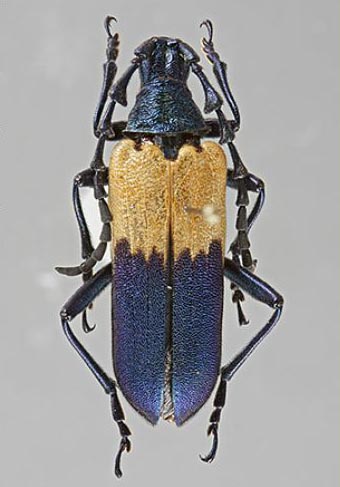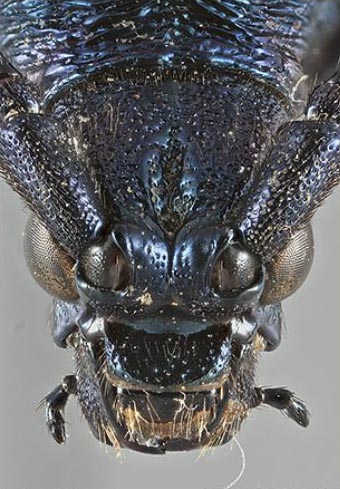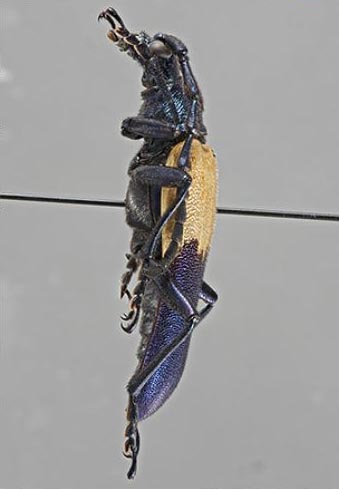 |
Desmocerini
Classification
Introduction
- The tribe Desmocerini Blanchard, 1845 currently contains 3 species in 1 genus. Photographs of 1 exemplar specimen are currently available for this tribe.
Diagnostic Features of Adults
- Body size variable, from small (less than 10 mm) to moderate-sized (between 10-40 mm); generally ovoid; with or without metallic reflection. Antennae variable, from filiform to expanded laterally; antennae short (not extending beyond tip of abdomen). Pronotum generally transverse, distinctly wider than long; lateral margins of pronotum unarmed, without distinct spines or tubercles.
- Mandibles short, broad, without an internal pubescent fringe (Linsley & Chemsak, 1972).
Diagnostic Features of Larvae
- Larva. Form elongate, robust, slightly depressed; integument firm, shining, glabrous except for a few long hairs. Head sub-orbicular, tapering in front, sparse long setae on front and gena; mouth-frame strongly corneous and entire head somewhat more than usually chitinized; epistoma thin, semi-tuberculate in middle; clypeus and labrum thin, latter narrowly transverse; mandible short, black, shining, cutting edge short, truncate, dorsal angle of cutting edge not produced; antennae very small, entirely retractile into fovea; ocelli three, prominent, bead-like. Ventral mouthparts slender; mentum elongate, tapering; lacinia, conical slender, beset with several hairs; last joint of palpi acutely conical, equal to second; gula not distinct, indefinably fused with submentum. Prothorax transverse, trapezoidal, widest in front; pronotum smooth, shining, posterior edge faintly reticulated, anterior strongly punctate. Eusternum acutely triangular, glabrous, shining, except for several hairs; mesonotum and metanotum not tuberculate, faintly shining; sternum tuberculate; legs very long, tibia longest joint, tarsus short, chitinous-tipped, appendiculate. Abdomen: Ampullae broad, flattened, tubercles ill-defined, confluent; epipleurum distinct on all segments; pleural tubercle narrowly oval, bearing two long setae; tergum of ninth segment broad, extending over anal lobes. Spiracles large, orbicular, deep, peritreme very thin. Pupa. Anterior area of pronotum beset with short, subulate hairs; first six abdominal terga bearing numerous recurved, conical spines, more abundant on posterior margin, seventh and eighth terga bearing attenuate hairs from chitinous pores, ninth with two widely separated, long, slender spines, extending laterally and posteriorly. Adapted from Craighead (1923).
Geographic Distribution of Tribe
Biology and Economic Importance
- The larvae feed in the living roots of Sambucus, working deep under the ground until nearly matured, when they come up through the pith and excavate the pupal cell. The mines are packed with coarse, fibrous frass, which is often exuded in large quantities at the base of the stems. Various sizes of larvae can be found at the same time, indicating a larval period of several years. Pupation occurs through April and May. The adults feed on the flowers. Range, throughout the eastern and central US and Canada. Adapted from Craighead (1923).
Selected References to Adult Specimens
Selected References to Larvae Specimens
|  |

Desmocerus palliatus
(Forster, 1771); dorsal
Cerambycidae:Lepturinae:Desmocerini
Photograph © N.P. Lord

Desmocerus palliatus
(Forster, 1771); head
Cerambycidae:Lepturinae:Desmocerini
Photograph © N.P. Lord

Desmocerus palliatus
(Forster, 1771); lateral
Cerambycidae:Lepturinae:Desmocerini
Photograph © N.P. Lord
|




